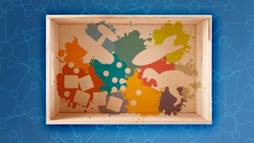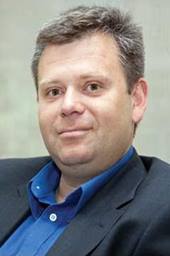Seeing Quarks and Gluons Through Jets and Silhouettes
 Photo credit N/A
Photo credit N/A
Seing Inside Nature's Toy Box: Artistic rendering of quarks and gluons being imaged using Ivan Vitev's new technology.
Image a handful of plastic toys and glass marbles tossed into a large storage box. You can't see through the box or move it, but you need to know what's inside.
Except the toys are quarks and gluons, the exotic particles that make up protons and nuclei. And the box is an extremely dense "soup" of particles that is thousands of times hotter than the sun's core.
For Ivan Vitev, the challenge of studying these particles which last for just a millionth of a billionth of a second was too much to resist. And, thanks to a U.S. Department of Energy Early Career Research Program Award, he's found a new way to learn about the arrangement of quarks and gluons, which are at the heart of all matter. "Understanding the nature of matter is at the heart of all practical applications," said Ivan.
Ivan's interest in these fundamental particles began during his studies in Bulgaria. When he graduated in 1995, he realized that funding was scarce in his native country. He packed up his research notes and books, and moved to New York to study at Columbia University.
He earned three degrees, including a doctorate in theoretical nuclear physics, and completed two postdoctoral appointments, including the Oppenheimer fellowship at Los Alamos National Laboratory.
After earning his U.S. citizenship, he settled at Los Alamos National Laboratory in New Mexico. There, he worked even harder at explaining how quarks and gluons might behave in those fleeting moments when they are free and shifting around inside the plasma and also received the Presidential Early Career Awards for Scientists and Engineers. Ivan tested those explanations inside massive colliders, such as the Relativistic Heavy Ion Collider at Brookhaven National Laboratory in New York.
 Photo courtesy NNSA
Photo courtesy NNSA
Using funding from a 2012 U.S. Department of Energy Office of Science's early career award, Ivan Vitev is unlocking the secrets of the building blocks of protons and nuclei.
Inside the collider, bunches of heavy nuclei – clumps of neutrons and protons – take off in opposite directions on a circular track, approach speeds near that of light, and crash into each other. The result? Bits of dense plasma packed with quarks, gluons, and other "stuff" that is then analyzed by detectors at the collider.
However, these conventional techniques didn't provide enough detail. Using funding from a 2012 U.S. Department of Energy Office of Science early career award, he got his chance to step up his game. "I consider myself very fortunate to have received this award," said Ivan.
Each award funds a scientist for five years. The $2.5-million grant allowed him to devise and test a new way to study the fundamental particles.
While firing quarks and gluons into the plasma is not a new idea, Ivan took it to the next level by using showers of such energetic particles, called jets, and having the jets originate inside the plasma. Using the earlier analogy, imagine sneaking a few squirt guns into the box. Trigger the pistols remotely. The resulting streams are deflected by the toys. If you have sensors that are sensitive enough to measure how the streams are deflected, you'll learn more about the toys, and how they're nestled against one another.
"It is a nontrivial system, even though it doesn't always seem that way," said Ivan. "A lot of effort goes into understanding the energetic jets and how they interact."
His approach is now being used by other nuclear physicists as it lets them delve into different theories about the gluons and quarks. Dousing each new batch of quark-gluon plasma with energetic particles provides more information about the nature of matter in extreme environments.
The environments are far less extreme, but no less challenging, at the workshop series Ivan hosted early in his career. He found that the biggest challenge was the language barrier. Not between Germans and Chinese, but rather between nuclear physicists and scientists from other disciplines. "Terms like 'jets' and 'evolutionary' mean very different things to different scientists," said Ivan. "We had to start with the basics – what the terms mean – and then accelerate into the science."
The jet-based approach was something Ivan only imagined when he was developing theories about protons' building blocks. Now, these jets are working at the Large Hadron Collider and the Relativistic Heavy Ion Collider, letting nuclear scientists use the brief micro-moment when quarks and gluons are freed to understand how matter truly works.
The Office of Science is the single largest supporter of basic energy research in the physical sciences in the United States and is working to address some of the most pressing challenges of our time. For more information please visit http://science.energy.gov.
Kristin Manke is a Communications Specialist at Pacific Northwest National Laboratory on detail to the U.S. Department of Energy's Office of Science, kristin.manke@science.doe.gov.

